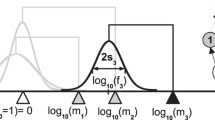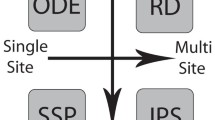Abstract
The distributions of species lifetimes and species in space are related, since species with good local survival chances have more time to colonize new habitats and species inhabiting large areas have higher chances to survive local disturbances. Yet, both distributions have been discussed in mostly separate communities. Here, we study both patterns simultaneously using a spatially explicit, evolutionary meta-food web model, consisting of a grid of patches, where each patch contains a local food web. Species survival depends on predation and competition interactions, which in turn depend on species body masses as the key traits. The system evolves due to the migration of species to neighboring patches, the addition of new species as modifications of existing species, and local extinction events. The structure of each local food web thus emerges in a self-organized manner as the highly non-trivial outcome of the relative time scales of these processes. Our model generates a large variety of complex, multi-trophic networks and therefore serves as a powerful tool to investigate ecosystems on long temporal and large spatial scales. We find that the observed lifetime distributions and species–area relations resemble power laws over appropriately chosen parameter ranges and thus agree qualitatively with empirical findings. Moreover, we observe strong finite-size effects, and a dependence of the relationships on the trophic level of the species. By comparing our results to simple neutral models found in the literature, we identify the features that affect the values of the exponents.







Similar content being viewed by others
References
Allhoff KT, Drossel B (2013) When do evolutionary food web models generate complex structures?. J Theor Biol 334:122–129. https://doi.org/10.1016/j.jtbi.2013.06.008. http://www.sciencedirect.com/science/article/pii/S0022519313002804
Allhoff KT, Ritterskamp D, Rall BC, Drossel B, Guill C (2015) Evolutionary food web model based on body masses gives realistic networks with permanent species turnover. Sci Rep 5:10955. https://doi.org/10.1038/srep10955
Allhoff KT, Weiel EM, Rogge T, Drossel B (2015) On the interplay of speciation and dispersal: an evolutionary food web model in space. J Theor Biol 366:46–56. https://doi.org/10.1016/j.jtbi.2014.11.006
Arrhenius O (1921) Species and area. J Ecol 9(1):95–99
Azaele S, Suweis S, Grilli J, Volkov I, Banavar JR, Maritan A (2016) Statistical mechanics of ecological systems: neutral theory and beyond. Rev Mod Phys 88:035,003. https://doi.org/10.1103/RevModPhys.88.035003. https://link.aps.org/doi/10.1103/RevModPhys.88.035003
Bak P, Sneppen K (1993) Punctuated equilibrium and criticality in a simple model of evolution. Phys Rev Lett 71(24):4083
Barnosky AD, Matzke N, Tomiya S, Wogan GO, Swartz B, Quental TB, Marshall C, McGuire JL, Lindsey EL, Maguire KC et al (2011) Has the earth’s sixth mass extinction already arrived? Nature 471(7336):51–57
Barter E, Gross T (2017) Spatial effects in meta-foodwebs. Sci Report 7 (9980):2045–2322. https://doi.org/10.1038/s41598-017-08666-8
Bertuzzo E, Suweis S, Mari L, Maritan A, Rodríguez-Iturbe I, Rinaldo A (2011) Spatial effects on species persistence and implications for biodiversity. Proc Natl Acad Sci 108(11):4346–4351. https://doi.org/10.1073/pnas.1017274108. http://www.pnas.org/content/108/11/4346.abstract
Binzer A, Brose U, Curtsdotter A, Eklöf A, Rall BC, Riede JO, de Castro F (2011) The susceptibility of species to extinctions in model communities. Basic Appl Ecol 12(7):590–599. https://doi.org/10.1016/j.baae.2011.09.002. http://www.sciencedirect.com/science/article/pii/S1439179111001150
Bolchoun L, Drossel B, Allhoff KT (2017) Spatial topologies affect local food web structure and diversity in evolutionary metacommunities. Sci Rep 7:1818
Brännström Å, Loeuille N, Loreau M, Dieckmann U (2011) Emergence and maintenance of biodiversity in an evolutionary food-web model. Theor Ecol 4(4):467–478
Calcagno V, Jarne P, Loreau M, Mouquet N, David P (2017) Diversity spurs diversification in ecological communities. Nature 8(15):810
Caldarelli G, Higgs PG, McKane AJ (1998) Modelling coevolution in multispecies communities. J Theor Biol 193:345–358. arXiv:adap-org/9801003v2
Caswell H, Cohen JE (1993) Local and regional regulation of species-area relations: a patch-occupancy model. Species diversity in ecological communities 7:99–107
Chesson P (2000) Mechanisms of maintenance of species diversity. Annu Rev Ecol Syst 31(1):343–366
Connor EF, McCoy ED (1979) The statistics and biology of the species-area relationship. Am Nat 113 (6):791–833
Dengler J (2009) Which function describes the species–area relationship best? A review and empirical evaluation. J Biogeogr 36(4):728–744
Desmet P, Cowling R (2004) Using the species–area relationship to set baseline targets for conservation. Ecol Soc 9(2):11
Drakare S, Lennon JJ, Hillebrand H (2006) The imprint of the geographical, evolutionary and ecological context on species–area relationships. Ecol Lett 9(2):215–227
Drossel B (1998) Extinction events and species lifetimes in a simple ecological model. Phys Rev Lett 81:5011–5014. https://doi.org/10.1103/PhysRevLett.81.5011. https://link.aps.org/doi/10.1103/PhysRevLett.81.5011
Drossel B (2001) Biological evolution and statistical physics. Adv Phys 50(2):209–295. https://doi.org/10.1080/00018730110041365. http://www.tandfonline.com/doi/abs/10.1080/00018730110041365
Drossel B, Higgs PG, McKane AJ (2001) The influence of predator-prey population dynamics on the long-term evolution of food web structure. J Theor Biol 208(1):91–107. https://doi.org/10.1006/jtbi.2000.2203. http://www.sciencedirect.com/science/article/pii/S0022519300922033
Durrett R, Levin S (1996) Spatial models for species-area curves. J Theor Biol 179(2):119–127
Gaston K, Blackburn T (2008) Pattern and process in macroecology. John Wiley & Sons
Gleason HA (1922) On the relation between species and area. Ecology 3(2):158–162
Gomulkiewicz R, Holt RD (1995) When does evolution by natural selection prevent extinction? Evolution 49(1):201–207
Gravel D, Canard E, Guichard F, Mouquet N (2011) Persistence increases with diversity and connectance in trophic metacommunities. PloS one 6(5):e19,374
Guill C, Drossel B (2008) Emergence of complexity in evolving niche-model food webs. J Theor Biol 251(1):108–120. https://doi.org/10.1016/j.jtbi.2007.11.017. http://www.sciencedirect.com/science/article/pii/S0022519307005760
Hairston NG, Ellner SP, Geber MA, Yoshida T, Fox JA (2005) Rapid evolution and the convergence of ecological and evolutionary time. Ecol Lett 8(10):1114–1127
Hanski I (1991) Single-species metapopulation dynamics: concepts, models and observations. Biol J Linn Soc 42(1-2):17–38
Hanski I (1994) A practical model of metapopulation dynamics. J Anim Ecol 63(1):151–162. http://www.jstor.org/stable/5591
He F, Legendre P (1996) On species-area relations. Am Nat 148(4):719–737
He F, Legendre P (2002) Species diversity patterns derived from species–area models. Ecology 83(5):1185–1198
Holt RD, Lawton JH, Polis GA, Martinez ND (1999) Trophic rank and the species–area relationship. Ecology 80(5):1495–1504
Keitt TH, Stanley HE (1998) Dynamics of north american breeding bird populations. Nature 393:257–260. https://doi.org/10.1038/30478
Kilburn PD (1966) Analysis of the species-area relation. Ecology 47(5):831–843
Kirkpatrick M, Barton NH (1997) Evolution of a species’ range. Am Nat 150(1):1–23
Lawson D, Jensen HJ (2006) The species–area relationship and evolution. J Theor Biol 241(3):590–600
Loeuille N, Leibold M (2008) Ecological consequences of evolution in plant defenses in a metacommunity. Theor Popul Biol 74(1):34–45
Loeuille N, Loreau M (2005) Evolutionary emergence of size-structured food webs. PNAS 102(16):5761–5766. https://doi.org/10.1073/pnas.0408424102. http://www.pnas.org/content/102/16/5761.abstract
Lomolino MV (2000) Ecology’s most general, yet protean pattern: The species-area relationship. J Biogeogr 27(1):17–26
MacArthur RH, Wilson EO (1963) An equilibrium theory of insular zoogeography. Evolution 17(4):373–387
Manrubia S, Paczuski M (1998) A simple model of large scale organization in evolution. Int J Modern Phys C 9(07):1025–1032
McCann KS, Rasmussen JB, Umbanhowar J (2005) The dynamics of spatially coupled food webs. Ecol Lett 8(5):513–523. https://doi.org/10.1111/j.1461-0248.2005.00742.x
Mcguinness KA (1984) Species–area curves. Biol Rev 59(3):423–440
Newman M (1996) Self-organized criticality, evolution and the fossil extinction record. Proc R Soc Lond B Biol Sci 263(1376):1605–1610
Newman M (1997) A model of mass extinction. J Theor Biol 189(3):235–252. https://doi.org/10.1006/jtbi.1997.0508. http://www.sciencedirect.com/science/article/pii/S0022519397905087
Newman M, Palmer R (1999) Models of extinction: A review. arXiv:adap-org/9908002
Norberg J, Urban MC, Vellend M, Klausmeier CA, Loeuille N (2012) Eco-evolutionary responses of biodiversity to climate change. Nat Clim Change 2(10):747–751. https://doi.org/10.1038/nclimate1588
Nunes Amaral LA, Meyer M (1999) Environmental changes, coextinction, and patterns in the fossil record. Phys Rev Lett 82:652–655. https://doi.org/10.1103/PhysRevLett.82.652. https://link.aps.org/doi/10.1103/PhysRevLett.82.652
Pantel JH, Duvivier C, Meester LD (2015) Rapid local adaptation mediates zooplankton community assembly in experimental mesocosms. Ecol Lett 18(10):992–1000
Pigolotti S, Cencini M, Molina D, Muñoz MA (2017) Stochastic spatial models in ecology: A statistical physics approach. Journal of Statistical Physics. https://doi.org/10.1007/s10955-017-1926-4
Pigolotti S, Flammini A, Marsili M, Maritan A (2005) Species lifetime distribution for simple models of ecologies. Proc Natl Acad Sci USA 102(44):15,747–15,751. https://doi.org/10.1073/pnas.0502648102. http://www.pnas.org/content/102/44/15747.abstract
Pillai P, Gonzalez A, Loreau M (2011) Metacommunity theory explains the emergence of food web complexity. Proc Natl Acad Sci 108(48):19,293–19,298
Pillai P, Loreau M, Gonzalez A (2010) A patch-dynamic framework for food web metacommunities. Theor Ecol 3(4):223–237. https://doi.org/10.1007/s12080-009-0065-1
Plitzko SJ, Drossel B (2015) The effect of dispersal between patches on the stability of large trophic food webs. Theor Ecol 8(2):233–244
Raup D (1986) Biological extinction in earth history. Science 231(4745):1528–1533. https://doi.org/10.1126/science.11542058. http://www.sciencemag.org/content/231/4745/1528.abstract
Raup DM (1991) A kill curve for phanerozoic marine species. Paleobiology 17(1):37–48. https://doi.org/10.1017/S0094837300010332
Raup DM, Sepkoski JJ (1982) Mass extinctions in the marine fossil record. Science 215(4539):1501–1503. https://doi.org/10.1126/science.215.4539.1501. http://science.sciencemag.org/content/215/4539/1501
Richhardt J, Plitzko SJ, Schwarzmüller F, Drossel B (2015) The influence of the migration network topology on the stability of a small food web. Journal of Complex Networks. http://comnet.oxfordjournals.org/content/early/2015/07/21/comnet.cnv019.abstract
Rosindell J, Cornell SJ (2007) Species–area relationships from a spatially explicit neutral mpodel in an infinite landscape. Ecol Lett 10(7):586–595
Rossberg A, Ishii R, Amemiya T, Itoh K (2008) The top-down mechanism for body-mass-abundance scaling. Ecology 89(2):567–80. http://ukpmc.ac.uk/abstract/MED/18409445
Scheiner SM (2003) Six types of species-area curves. Glob Ecol Biogeogr 12(6):441–447. https://doi.org/10.1046/j.1466-822X.2003.00061.x
Sole RV, Bascompte J (1996) Are critical phenomena relevant to large-scale evolution? Proc R Soc Lond B Biol Sci 263(1367):161–168
Tjørve E (2003) Shapes and functions of species–area curves: a review of possible models. J Biogeogr 30(6):827–835
Triantis K, Mylonas M, Lika K, Vardinoyannis K (2003) A model for the species–area–habitat relationship. J Biogeogr 30(1):19–27
Urban MC, Leibold MA, Amarasekare P, De Meester L, Gomulkiewicz R, Hochberg ME, Klausmeier CA, Loeuille N, De Mazancourt C, Norberg J et al (2008) The evolutionary ecology of metacommunities. Trends Ecol Evol 23(6):311–317. https://doi.org/10.1016/j.tree.2008.02.007
Williams RJ, Martinez ND (2000) Simple rules yield complex food webs. Nature 404:180–182
Willis JC (1922) Age and area, The University Press, Cambridge
Yodzis P, Innes S (1992) Body size and consumer-resource dynamics. Am Nat 139:1151–1175
Zaoli S, Giometto A, Maritan A, Rinaldo A (2017) Covariations in ecological scaling laws fostered by community dynamics. Proc Natl Acad Sci 114(40):10,672–10,677. https://doi.org/10.1073/pnas.1708376114
žliobaitė I, Fortelius M, Stenseth NC (2017) Reconciling taxon senescence with the red queen’s hypothesis. Nature 552(7683): 92
Acknowledgements
The bachelor thesis of Johannes Reinhard contributed to the initial stage of this study by demonstrating that including a spontaneous extinction rate is essential for obtaining an ongoing species turnover.
Author information
Authors and Affiliations
Corresponding author
Additional information
This work was supported by the German Research Foundation (DFG) under contract numbers Dr300/12 and Dr300/13. KTA was additionally supported by the French National Research Agency (ANR) through project ARSENIC (grant no. 14-CE02-0012).
Electronic supplementary material
Below is the link to the electronic supplementary material.
Rights and permissions
About this article
Cite this article
Rogge, T., Jones, D., Drossel, B. et al. Interplay of spatial dynamics and local adaptation shapes species lifetime distributions and species–area relationships. Theor Ecol 12, 437–451 (2019). https://doi.org/10.1007/s12080-019-0410-y
Received:
Accepted:
Published:
Issue Date:
DOI: https://doi.org/10.1007/s12080-019-0410-y




